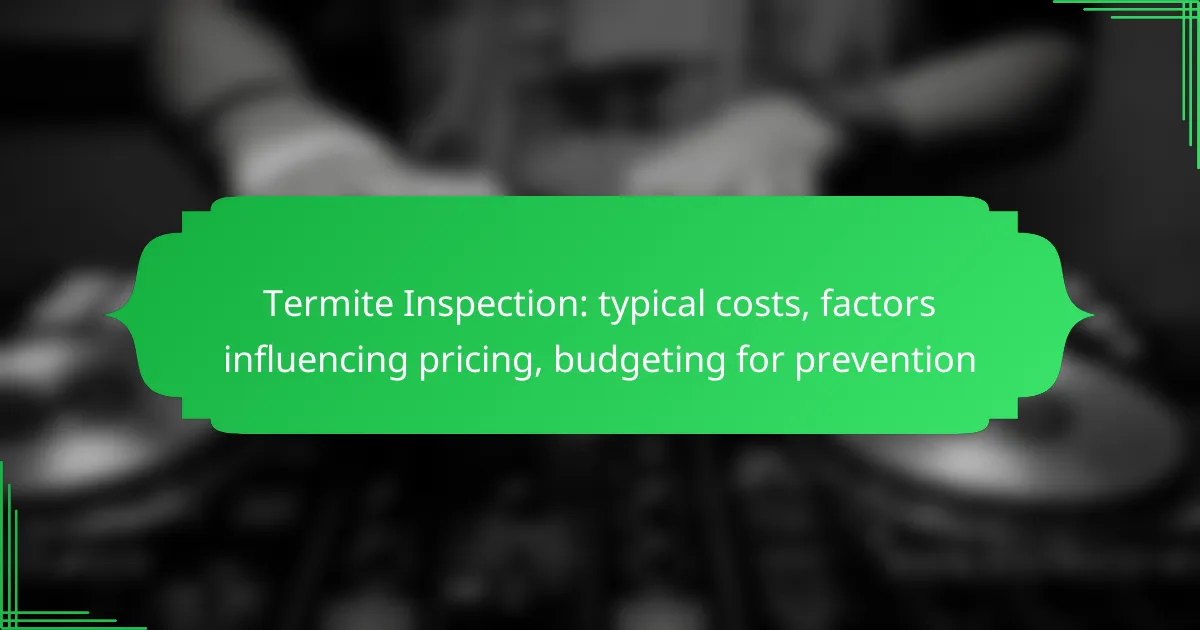Termite inspections are a crucial step in maintaining a pest-free home, with average costs in the United States ranging from $75 to $300. Pricing can vary based on factors such as property size, location, and the specific services offered. By understanding these elements, homeowners can effectively budget for both inspections and necessary prevention measures, ultimately saving on potential repair costs in the future.
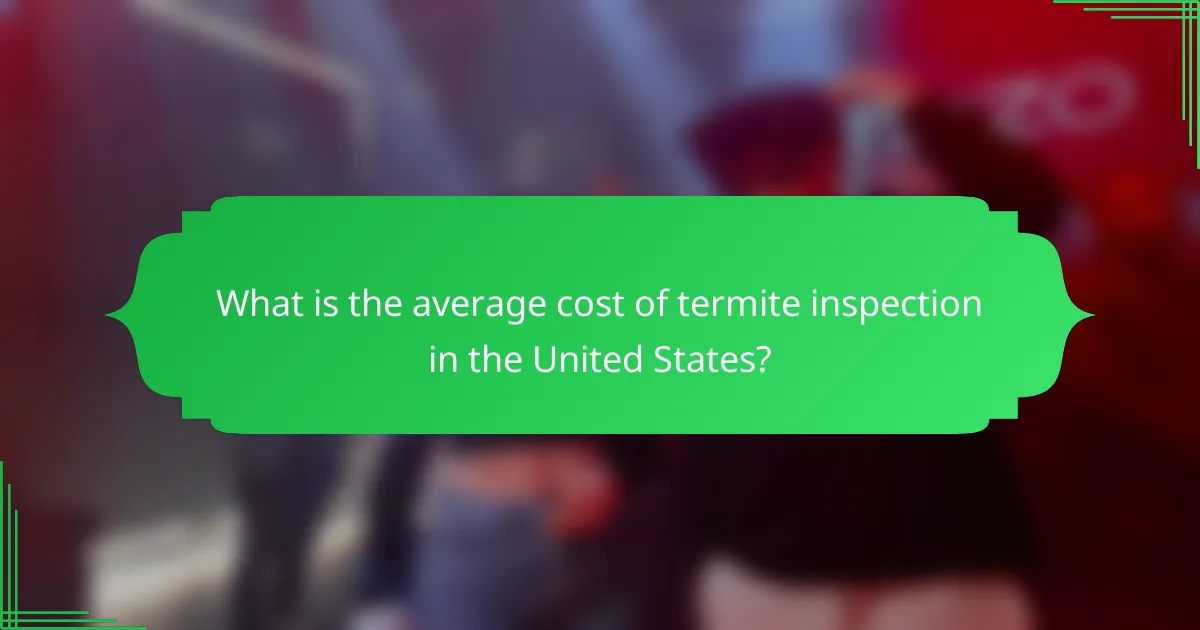
What is the average cost of termite inspection in the United States?
The average cost of termite inspection in the United States typically ranges from $75 to $300. This price can vary based on several factors, including the size of the property and the specific services included in the inspection.
Typical inspection costs range from $75 to $300
Most homeowners can expect to pay between $75 and $300 for a termite inspection. Basic inspections, often performed by general pest control companies, tend to be on the lower end of this range. More comprehensive inspections, which may include detailed reports and follow-up services, can reach the higher end.
Some companies offer free inspections as part of their service, but be sure to check if additional fees apply for follow-up treatments or reports. Always clarify what is included in the quoted price to avoid unexpected costs.
Factors affecting costs include property size and location
The size of the property significantly influences the cost of a termite inspection. Larger homes generally require more time and resources to inspect, leading to higher fees. For example, a small apartment may cost less than a sprawling single-family home.
Location also plays a crucial role in pricing. Urban areas with higher living costs may see inspection fees at the upper end of the range, while rural areas might offer lower prices. Additionally, local demand for pest control services can affect pricing, so it’s wise to compare quotes from multiple providers in your area.
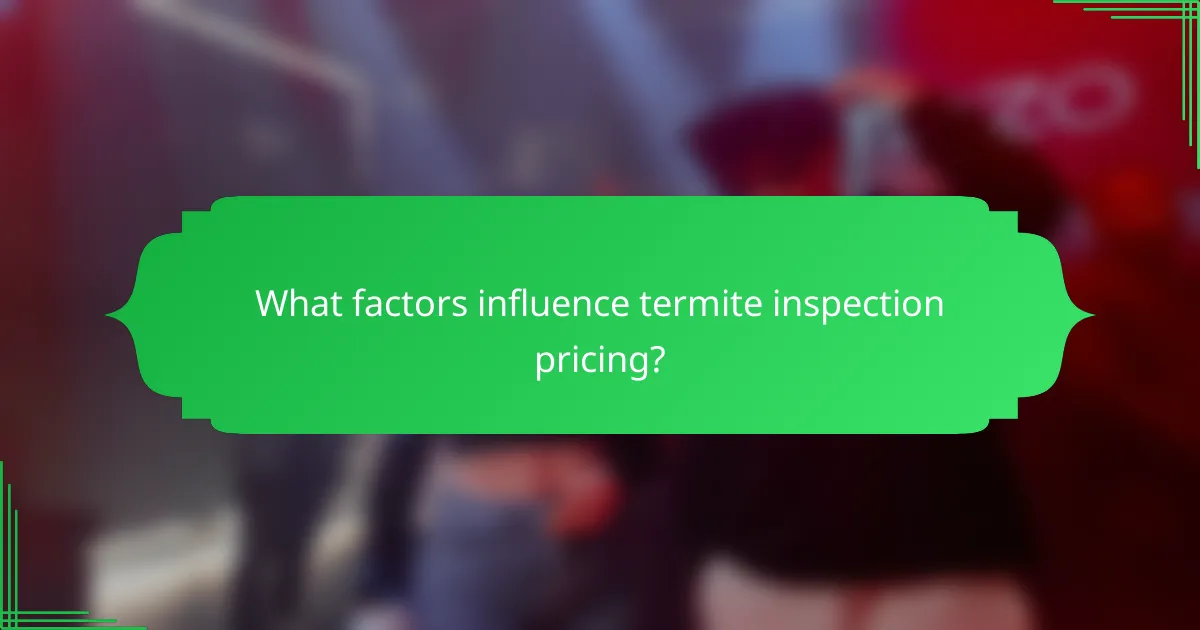
What factors influence termite inspection pricing?
Termite inspection pricing is influenced by several key factors, including the size and complexity of the property, geographic location, and the type of inspection performed. Understanding these elements can help homeowners budget effectively for inspections and potential treatments.
Property size and complexity
The size and complexity of a property significantly affect inspection costs. Larger homes or those with multiple levels may require more time and resources to inspect thoroughly, leading to higher fees. For instance, a small single-story home might cost less than a multi-story building with intricate designs.
Additionally, properties with unique features like crawl spaces, basements, or extensive landscaping can complicate inspections. Inspectors may need specialized equipment or additional time to assess these areas, which can further increase costs.
Geographic location and market demand
Geographic location plays a crucial role in determining termite inspection pricing. Regions that are more prone to termite infestations, such as the southern United States, may have higher demand for inspections, driving up costs. In contrast, areas with lower termite activity may see more competitive pricing.
Local market conditions also impact costs. In urban areas where demand for pest control services is high, prices may be elevated compared to rural locations. Homeowners should research local rates and consider obtaining multiple quotes to find the best value.
Type of inspection (visual vs. thermal)
The type of inspection chosen can greatly influence the overall cost. A standard visual inspection typically involves a thorough examination of accessible areas and may be less expensive. However, it may not detect hidden infestations.
In contrast, thermal inspections use specialized equipment to identify temperature variations that indicate termite activity. While these inspections can be more effective, they often come at a higher price point. Homeowners should weigh the benefits of thoroughness against their budget when deciding on the type of inspection to pursue.

How can homeowners budget for termite prevention?
Homeowners can budget for termite prevention by understanding typical costs and incorporating regular inspections into their financial planning. Setting aside funds for prevention measures can save significant expenses related to damage repairs in the long run.
Annual prevention costs typically range from $200 to $500
The annual costs for termite prevention generally fall between $200 and $500, depending on the size of the property and the methods used. Treatments may include bait systems, liquid chemical barriers, or a combination of both.
For example, a small home may only require basic treatments, while larger properties or those in high-risk areas could incur higher costs. It’s wise to obtain quotes from multiple pest control companies to ensure competitive pricing.
Consider regular inspections as part of the budget
Regular inspections are crucial for effective termite prevention and should be factored into your budget. These inspections typically cost between $75 and $150 and can help identify potential infestations before they escalate.
Scheduling inspections annually or bi-annually can provide peace of mind and protect your investment. Many pest control companies offer bundled services that include inspections along with treatment plans, which can be more cost-effective.

What are the signs of termite infestation?
Signs of termite infestation include visible damage to wood structures and the presence of mud tubes. Recognizing these indicators early can help prevent extensive damage and costly repairs.
Visible mud tubes and wood damage
Termites often create mud tubes to travel between their nests and food sources. These tubes, which are about the width of a pencil, can be found along walls, foundations, and in crawl spaces. If you notice these tubes, it’s a clear sign of termite activity.
Additionally, wood damage is a significant indicator. Look for hollowed-out wood, which may sound hollow when tapped. This damage can compromise the structural integrity of your home, making early detection crucial.
Swarmers and discarded wings
Swarmers are reproductive termites that leave the colony to establish new ones. If you see these winged insects inside or around your home, it indicates a nearby infestation. Swarmers typically emerge in the spring and are attracted to light.
After swarming, these termites shed their wings, which can often be found near windowsills or light fixtures. Finding discarded wings is a strong indication that termites are present, and immediate action should be taken to assess the situation.

How often should termite inspections be conducted?
Termite inspections should typically be conducted at least once a year to effectively monitor and prevent infestations. Regular inspections help identify potential issues early, allowing for timely intervention and reducing the risk of significant damage.
Annual inspections are recommended
Annual termite inspections are essential for homeowners to ensure their properties remain free from infestations. These inspections allow professionals to assess the structure for signs of termite activity and damage, which can be costly if left unchecked. The cost for an annual inspection usually ranges from $100 to $300, depending on the size of the property and the region.
During an annual inspection, technicians will check common entry points, such as basements, crawl spaces, and attics, as well as the surrounding landscape. Homeowners should keep records of these inspections to track any changes over time and to inform future treatments.
More frequent inspections for high-risk areas
In areas known for high termite activity, more frequent inspections may be necessary. Properties located near woodlands, wetlands, or regions with a history of termite problems should consider biannual or quarterly inspections. This proactive approach can help catch infestations before they escalate.
Homeowners in high-risk areas should also be vigilant about maintaining their properties. Simple measures like reducing moisture, sealing cracks, and removing wood debris can significantly lower the risk of termite infestations. Consulting with a pest control professional can provide tailored recommendations based on local conditions and property specifics.
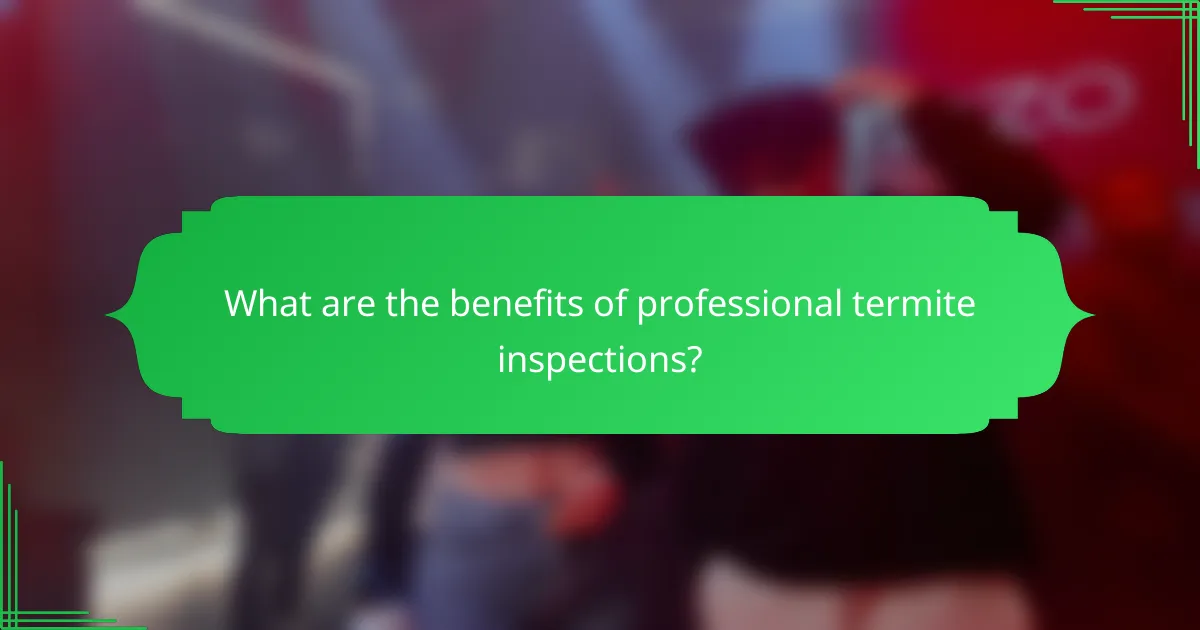
What are the benefits of professional termite inspections?
Professional termite inspections provide essential advantages, including early detection of infestations and a thorough assessment of property condition. These inspections can save homeowners significant costs by identifying problems before they escalate.
Early detection of infestations
Early detection of termite infestations is crucial for preventing extensive damage. Professional inspectors use specialized tools and techniques to identify signs of termites, often before they become visible to homeowners. This proactive approach can save thousands in repair costs.
For instance, a typical inspection may reveal hidden infestations in walls or foundations, allowing for targeted treatment. Homeowners should schedule inspections at least annually, especially in areas prone to termite activity.
Comprehensive assessment of property condition
A comprehensive assessment during a termite inspection evaluates the overall condition of the property, including structural integrity and potential vulnerabilities. Inspectors look for moisture issues, wood damage, and conducive conditions that may attract termites.
This detailed evaluation helps homeowners understand their property’s health and prioritize necessary repairs or preventative measures. Investing in a professional inspection can lead to informed decisions about maintenance and pest control strategies, ultimately protecting the property’s value.

How do different inspection methods compare?
Different termite inspection methods vary in effectiveness and cost. Choosing the right method depends on the specific needs of the property and the extent of potential infestations.
Visual inspections are cost-effective
Visual inspections are the most common and budget-friendly method for detecting termite activity. Typically, these inspections cost between $50 and $200, depending on the property’s size and location.
During a visual inspection, a trained professional examines accessible areas for signs of termites, such as mud tubes, damaged wood, or discarded wings. Homeowners can also perform basic visual checks themselves, focusing on basements, crawl spaces, and around foundations.
Thermal imaging detects hidden infestations
Thermal imaging is a more advanced method that can identify hidden termite infestations by detecting temperature differences in walls and structures. This technique is generally more expensive, with costs ranging from $200 to $500.
Using thermal cameras, inspectors can pinpoint areas where termites may be present without causing damage to the property. This method is particularly useful in larger homes or when previous inspections have raised concerns about hidden infestations.
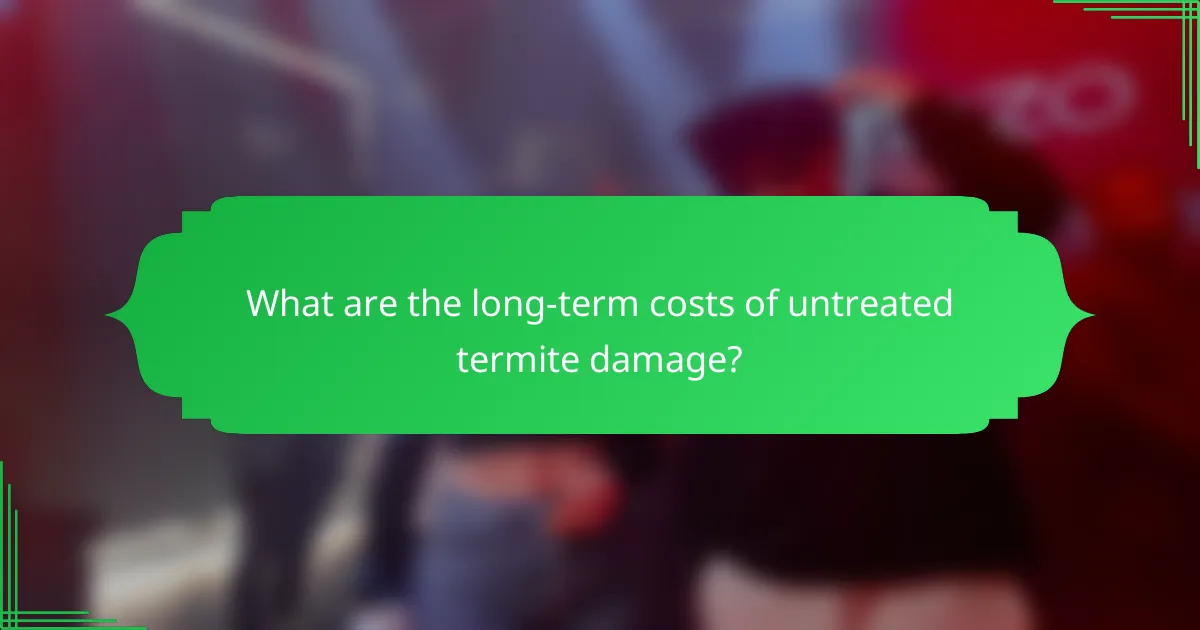
What are the long-term costs of untreated termite damage?
Untreated termite damage can lead to significant long-term costs, often amounting to thousands of dollars in repairs. The structural integrity of a home can be compromised, resulting in extensive damage that requires professional intervention and costly repairs.
Potential repair costs can exceed $10,000
Repairing damage caused by termites can be financially burdensome, with costs often exceeding $10,000. This figure can vary based on the extent of the infestation and the specific repairs needed, such as replacing beams, flooring, or drywall.
For example, if termites have compromised load-bearing structures, the costs can escalate quickly. Homeowners should be aware that the longer the infestation goes untreated, the more severe the damage and the higher the repair costs will be.
To avoid such expenses, regular inspections and preventative measures are crucial. Investing in termite prevention can save homeowners from facing substantial repair bills in the future.
